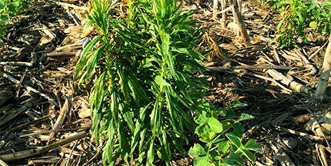Spring is in the air! The grass is greening up, the songbirds are back serenading us, each day is getting longer, the daily temperature is sort of warming up, and snow is changing to rain (for the most part). But that is the problem, isn’t it? Temps are staying lower than average, and the precipitation does not seem to want to stay away for longer than a 48-hour stretch, at best. In Champaign, the average temperature for the month of April so... Read More →
ILSOYADVISOR POST
It’s Never too Late in the Fight Against Weeds
May 22, 2020
When Roundup Ready® soybeans were introduced, times were good. You could schedule your spray application from the calendar and not think twice about whether your fields were going to stay clean. Mother Nature has since prevailed, showing scientists who is boss and showing us what we’ve been taking for granted. In the perfect scenario you would see a weed-free field with an ideal spring, but that’s not so common anymore. We now must take extra time and effort to find that right weed control program.

courtesy of University of Illinois.
- Burndown
- Pre-plant incorporated
- Pre-emergence
All great places to start, but what if you didn’t have time? Torrential downpours and muddy fields sound more like what we’ve experienced in recent years, so you are left with a post-emergence situation. What are the best ways to manage this type of system?
- Plant soybean resistant varieties with more than one mode of action
- Do not cut the labeled rate for effective control
- Apply post-spray as soon as possible, before canopy
- Scout – escaped weeds might need a second application
Herbicides, like Group 4 growth regulators, have been around since the good old days, but it’s not until recent years that we have seen a soybean able to metabolize and resist their effects. Growth regulators have great control on a wide variety of weeds, but they’re no silver bullet. That’s the reason for the introduction of soybeans resistant to multiple modes of action. Glyphosate still has its place with good control on many grasses and works well for a burndown coupled with a Group 4 herbicide. Now that option is available for a post-emergence spray.

herbicide application. Photo courtesy
of University of Nebraska-Lincoln.
Saving money now might cost you down the road. Choosing to cut corners and cut rates of a post herbicide can just make weeds angry. We have all seen this with weeds, like marestail, that will look dead and then magically show signs of life to only green up and poke through the soybean canopy. High-quality adjuvants also help the herbicide perform as it should, so use them and the full recommended rate to get the most out of an herbicide.
Relying on a post spray still has urgency, because another one might be needed. The weather is unpredictable and causes herbicides to perform questionably at times. You might find a pop-up rain right behind the sprayer, temperature fluctuations that slow the translocation of herbicides, or a second pass could be warranted simply just to clean up some tough weeds. The smaller the better when trying to knock them down. Controlling the escapes will also help reduce some of the pressure for next year if they are stopped before producing seed. The weeds that make it through the initial pass won’t be found unless scouting is done, but late emerging weed seeds won’t be noticed until it is too late if you don’t look for them.
Competition can be a good thing, but not in your soybean field. Start clean and stay clean, a common phrase that should be taken seriously, but that is not always guaranteed in today’s climate. Scouting early and continuing to manage difficult weeds if they get away could help grow the bottom line of a profitable soybean crop.





Comments
Add new comment